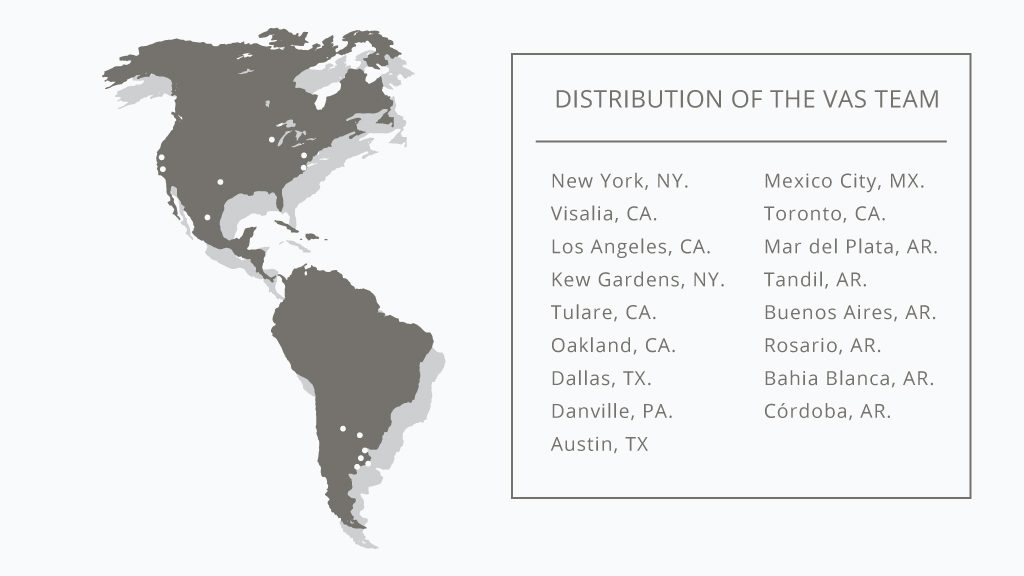For many years, the idea that the only effective way to work was face-to-face predominated within the “mantra” of the team management disciplines. Nowadays, and thanks to advances in technology, it’s completely possible to reach high levels of efficiency and productivity working remotely. Of course, without a doubt, this is not a simple thing, especially for those who lack experience managing teams that are distributed across the world, but it’s not impossible.
At Making Sense, based on our expertise and clear processes, we can create great remote working environments for our teams and partners.
A good example of that could be our experience with Valley Agricultural Software (VAS), one of the most important Dairy Management companies in the US. We have been working together for more than 3 years, with teams distributed among US, Mexico and Argentina, achieving productivity and quality levels above expectations (you can see more of our work in this link).
Our team grew from 5 professionals to more than 40 in about 3 years. Both teams are distributed in different countries and cities, we have daily meetings via Zoom, instant communications via Slack, Scrum ceremonies and a well-performing agile process. What’s most important: we do not only put a team together, we developed a strategic technology roadmap and uncovered many compliance-based, operational problems, especially in terms of the ability to reconcile and keep track of where customers were.
We brought more to the table than software expertise. We delivered insight, perspective, true vision and leadership that enabled VAS to stay ahead of the competition. And yes…all of this, working remotely!

So, based on our experience, we’ve gathered the most important tips, you should follow to achieve good performance.
It’s all about communication
Whether your team is all together under the same roof or not, communication stands as the single most valuable factor you need to consider. By communicating the project needs, the tasks and priorities, you can ensure your team is on the same page and has a clear understanding of what they are supposed to do. So, in this way, although you have an in-house team, if you don’t communicate accordingly you will fail.
Now, how can we ensure good communication while working remotely?
First of all, we must establish clear processes and work methods that include daily meetings, and as many points of contact you need for your project. Then set up the necessary tools for communicating well with the team and use every digital tool you have available to facilitate communication. Connect over text messaging, Slack, emails, and Zoom video conferences. Use group chats as the backchannel during online meetings. Let people use what they are comfortable with to ease discussion.
Another thing you must consider is working asynchronously. Many times, problems or just some concerns can be resolved in an email, chat, or an online discussion. So, take advantage of that instead of setting up a meeting.

Some of the practices we recommend
Through our experience working with remote teams, and building strong relationships with them, we’ve learned that there are some tips you must have in mind when you are working with a remote team:
- Establish an infrastructure to enable successful communication
- When hiring, consider the candidate’s background and past experience. Look for those who used to work in teams
- Emphasize the importance of communication and transparency
- Promote mutual trust, speak openly, and give them the autonomy to succeed
- Provide the team with the right tools to better organize things and to keep everyone on the same page
- Have periodic one-on-one meetings with each team member
- Increase communication, provide a direct channel, and encourage remote team members to ask anything
- Define which is the official communication tool
- Promote a culture of agility, ownership, and trust
How to build a culture working with remote teams
A common concern that arises when someone is thinking about starting to work with a remote team is how we can build a culture if the team is not face-to-face. As we mentioned in one of our previous posts, there is no such thing as a quick path to building company culture, and remote teams certainly are no exception, but it’s not impossible.
Here’s our advice based on our experience:
- Build a team of people fluent in the chosen language — in our case English
- Consider time zones when staffing team roles
- Learn the cultural differences associated with team member locations, and keep them in mind when facilitating team interactions
- Focus on a good onboarding experience
- Find some time and space to talk about cultural matters
- Reinforce the company’s mission, purpose, and values
These are just some of the tips you should consider.

Why working with remote teams
Sometimes there are situations that force your company to embrace remoteness without exception. And even if you are thinking that this is not a good idea, you should understand that this can offer competitive advantages to boosting your business.
As companies and the world are becoming more digital, we need more engineers. So you have to go outside your city boundaries to ask them to join your project. By configuring a team with folks from all over the world, you will create an environment where multiculturality thrives and this sparks innovation. Also, employees consider flexible schedules and remote work as the most valuable aspects in the pursuit of a work-life balance, so we can affirm that the remote work attracts and retains talent.
The more perspectives and ideas there are, the better your results will be. So don’t be afraid to work with a team that is not under the same roof. The team and all the team relationships can thrive in this challenging environment if you are ready.
The first step is convincing everyone of the benefits — better team performance and lower costs — value propositions that translate well to managers, senior executives, teams, clients, and partners alike. And when you’re developing a software solution, these considerations simply can’t be ignored, because they are, for sure, a competitive advantage for your business.
